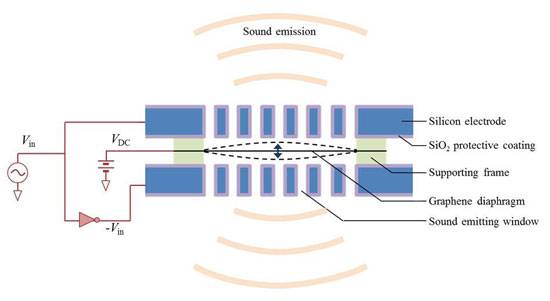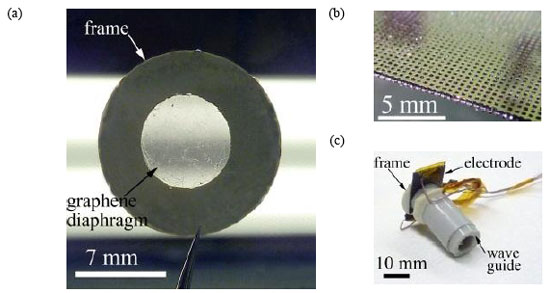| Posted: Mar 21, 2013 | |
Experimental graphene earphones outperform most commercial headsets |
|
| (Nanowerk Spotlight) In two previous Nanowerk Spotlights, we reported about work by a group of Chinese scientists that demonstrated that carbon nanotube sheets can act as powerful thermoacoustic loudspeakers ("Nanotechnology that will rock you") and of results by a team from UT Dallas that observed surprisingly high underwater sound generation efficiency using multi-walled carbon nanotube sheets ("Nanotechnology loudspeakers keep on rocking - even underwater"). | |
| Now, Alex Zettl's group at the University of California at Berkeley has exploited the extraordinary electrical and mechanical properties of graphene to create a very efficient electrical/sound transducer. | |
| "Our graphene loudspeaker, without any optimized acoustic design, is simple to make and already performs comparably to or better than similar sized commercial counterparts, and with much lower power consumption," Zettl tells Nanowerk. | |
| Zettl and Qin Zhou, a postdoc researcher in his group, describe their graphene speaker design in a paper currently posted on arXiv ("Electrostatic Graphene Loudspeaker"). | |
 |
|
| Schematics of the electrostatically driven graphene speaker. A graphene diaphragm, biased by a DC source, is suspended midway between two perforated electrodes driven at opposite polarity. The varying electrostatic force drives the graphene diaphragm which in turn disturbs air and emits sound through the electrodes. The light mass and low spring constant of the graphene diaphragm, together with strong air damping, allow for high-fidelity broad-band frequency response. Such a speaker also has extremely high power efficiency. (Image: Dr. Zettl, UC Berkeley) | |
| "For human audibility, an ideal speaker or earphone should generate a constant sound pressure level from 20 Hz to 20 kHz, i.e. it should have a flat frequency response," explains Zettl. "Most speakers available today reproduce sound via a mechanical diaphragm, which is displaced oscillatorily during operation. A wide-band audio speaker typically requires significant damping to broaden the response and, unfortunately, 'damping engineering' quickly becomes complex and expensive, with inevitable power inefficiencies." | |
| Graphene, though, is an ideal building material for small, efficient, high-quality broad-band audio speakers because it satisfies all the criteria for an ideal audio transduction diaphragm – it should have small mass and a soft spring constant, and be non-perforated to efficiently displace the surrounding air. | |
| Graphene's extremely low mass produces flat frequency response. Its high mechanical strength allows construction of relatively large and thin membrane for efficiently generating sound. Finally, good electrical conductivity means the membrane does not need to be "metallized"; it already is. | |
| "The electrostatic graphene speaker has a fairly flat frequency response in the human audible region, low distortion and very low power consumption," says Zettl. "To our knowledge, it is the first one constructed." (Although graphene has been used previously to construct thermoacoustic speakers and piezoelectric speakers, but those have very poor frequency response and/or very poor power efficiency.) | |
| To fabricate their graphene earbuds, the two researchers sandwiched a 30 nm thin graphene film between two supporting frames and attached a 20 µm-diameter gold wire as the electrical contact. A prototype was fabricated simply by sandwiching the graphene diaphragm between two silicon electrodes. | |
 |
|
| Images of (a) 7mm diameter graphene diaphragm suspended across annular support frame, (b) actuating electrodes, and (c) assembled speaker. (Image: Dr. Zettl, UC Berkeley) | |
| "The sound generated by the graphene speaker is easily audible by the human ear" says Zettl. "The fidelity is qualitatively excellent when listening to music." | |
| This novel, electrostatically driven, high-efficiency, mechanically vibrating graphene-diaphragm based audio speaker exhibits excellent performance: Even without optimization, the speaker is able to produce frequency response across the whole audible region (20 Hz∼20 KHz), comparable or superior to performance of conventional-design commercial counterparts. | |
| Applications-wise, the two now plan to demonstrate a larger graphene speaker and a graphene microphone. | |
 By
Michael
Berger
– Michael is author of three books by the Royal Society of Chemistry:
Nano-Society: Pushing the Boundaries of Technology,
Nanotechnology: The Future is Tiny, and
Nanoengineering: The Skills and Tools Making Technology Invisible
Copyright ©
Nanowerk LLC
By
Michael
Berger
– Michael is author of three books by the Royal Society of Chemistry:
Nano-Society: Pushing the Boundaries of Technology,
Nanotechnology: The Future is Tiny, and
Nanoengineering: The Skills and Tools Making Technology Invisible
Copyright ©
Nanowerk LLC
|
|
|
Become a Spotlight guest author! Join our large and growing group of guest contributors. Have you just published a scientific paper or have other exciting developments to share with the nanotechnology community? Here is how to publish on nanowerk.com. |
|
